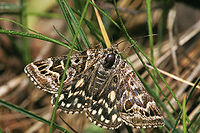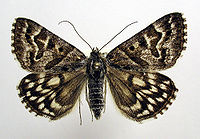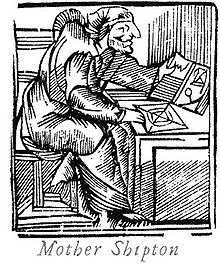- Mother Shipton Moth
-
Mother Shipton Moth 

Scientific classification Kingdom: Animalia Phylum: Arthropoda Class: Insecta Order: Lepidoptera Family: Noctuidae Genus: Callistege Species: C. mi Binomial name Callistege mi
Clerck, 1759Synonyms - Euclidia mi var. extrema
- Euclidia extrema
- Euclidia mi
- Phalaena litterata
- Callistege litterata
- Callistege mi elzei
- Callistege elzei
The Mother Shipton Moth, (Callistege mi) is a moth of the Noctuidae family. It was classified by Carl Alexander Clerck in 1759, and is also known under the name of Euclidia mi.[1] In Finnish it is known as Piirtoyökkönen and in German as Scheck-Tageule.[2] Its habitat spans over most of Europe, Siberia, the Far East and Asia Minor.[2] On the British Isles it is most common in England and Wales; less so in Scotland and Ireland.[3] It flies by day, normally taking only short, rapid flights,[3] and can be found in wasteland and other open habitats.[3] The adult moth's forewing is 13 to 16 mm (0.51 to 0.63 inches) long, and the wingspan is 25 to 30 mm (0.98 to 1.18 inches).[4] The stages of its life cycle are as follows: egg: May – September, larva: June – September, pupa: July – May, and imago: May – July.[4] It hibernates as a pupa, and does so in a cocoon among blades of grass, or right underneath the ground.[5] Among its foods is the nectar of the white clover and the creeping buttercup.[4]
The popular, English name for this moth comes from the pattern on its forewing. This pattern resembles the iconic representation of Ursula Southeil, known as Mother Shipton – a sixteenth-century prophetess and witch.[1] Mother Shipton is a mostly mythical character, who supposedly foretold the death of Cardinal Wolsey in 1530.[1] Charles Hindley, a nineteenth-century bookseller, created a prophetic poem that he claimed to be by Shipley.[6] This poem told of "Carriages without horses" and air planes, as well as predicting the end of the world in 1881.[7]
References
- ^ a b c Kellett, Arnold. The Yorkshire Dictionary of Dialect, Tradition and Folklore (2nd ed.). Otley: Smith Settle. pp. 117–8. ISBN 1858250161.
- ^ a b Savela, Markku. "Euclidia mi". http://www.funet.fi/pub/sci/bio/life/insecta/lepidoptera/ditrysia/noctuoidea/noctuidae/catocalinae/euclidia/index.html. Retrieved 2008-10-23.
- ^ a b c Kimber, Ian. "Mother Shipton Callistege mi". UK Moths. http://ukmoths.org.uk/show.php?id=4769. Retrieved 2008-10-23.
- ^ a b c Lindsey, J.K. (2005). "Callistege mi". The Ecology of Commanster. http://popgen.unimaas.nl/~jlindsey/commanster/Insects/Moths/SpMoths/Callistege.mi.html. Retrieved 2008-10-23.
- ^ De Prins, Willy; Chris Steeman. "Callistege mi (Clerck, 1759)". Flemish Entomological Society. http://webh01.ua.ac.be/vve/Checklists/Lepidoptera/Noctuidae/Cmi.htm. Retrieved 2008-10-23.
- ^ Simpson, Jacqueline (1991). "A Panic for the Year 2000?". Folklore (Folklore Enterprises, Ltd.) 101 (1): pp. 104–5. http://www.jstor.org/stable/1260362. Retrieved 2008-10-24.
- ^ Wilson, Pip. "Mother Shipton, England's Nostradamus lady". Wilson's Almanac. http://www.wilsonsalmanac.com/mother_shipton.html. Retrieved 2008-10-23.
Categories:- Ectypina
- Animals described in 1759
Wikimedia Foundation. 2010.


